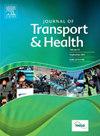Walkability evaluation and optimization based on pedestrian and environment interaction: an agent-based modeling approach
IF 3.2
3区 工程技术
Q2 PUBLIC, ENVIRONMENTAL & OCCUPATIONAL HEALTH
引用次数: 0
Abstract
Introduction
On one hand, this study proposes an evaluation framework for walkability in residential neighborhood based on interactions between pedestrians and the environment in four dimensions, and applies it to the measurement of walking activities on real streets using agent-based modelling (ABM). On the other hand, we designed multiple scenarios with different combinations of measures, and calculated their street evaluation index to determine the optimal optimization scheme.
Methods
This study employed a mixed-methods fieldwork approach, collecting data from 13 streets in Shenzhen and administering importance rating questionnaires (n = 238). Data collection took place on June 16, 2021, and June 19, 2021. Based on the research data and analysis results, we used the NetLogo simulation platform, combined with AutoCAD and ArcGIS, to construct the road network for simulation.
Results and conclusion
Most simulated streets exhibited varying characteristics of walking activity at different times of day. Streets with high assessed values showed minimal daily fluctuations, whereas those with medium to low values experienced greater fluctuations throughout the day. The design of street interfaces significantly impacts pedestrian walking activities, and the greening index affects different types of activities differently. It deters commercial and recreational activities but facilitates leisure activities. Scenario optimization results indicate that different combinations of optimization strategies yield different effects. This simulation-based method provides a nuanced understanding of how design changes can impact urban environments.
基于行人与环境交互作用的可步行性评价与优化:一种基于agent的建模方法
本研究一方面从四个维度提出了基于行人与环境相互作用的住宅小区步行性评价框架,并运用基于agent的模型(ABM)对真实街道上的步行活动进行了测量。另一方面,设计不同措施组合的多个场景,计算其街道评价指标,确定最优优化方案。方法本研究采用混合方法的实地调查方法,收集深圳市13条街道的数据,并进行重要性评定问卷(n = 238)。数据收集于2021年6月16日和2021年6月19日进行。根据研究数据和分析结果,利用NetLogo仿真平台,结合AutoCAD和ArcGIS,构建路网进行仿真。结果与结论大多数模拟街道在一天的不同时间表现出不同的步行活动特征。评估值高的街道每日波动最小,而评估值中低的街道全天波动较大。街道界面设计显著影响步行活动,绿化指数对不同类型活动的影响也不同。它阻碍了商业和娱乐活动,但促进了休闲活动。场景优化结果表明,不同的优化策略组合效果不同。这种基于模拟的方法提供了对设计变化如何影响城市环境的细致理解。
本文章由计算机程序翻译,如有差异,请以英文原文为准。
求助全文
约1分钟内获得全文
求助全文

 求助内容:
求助内容: 应助结果提醒方式:
应助结果提醒方式:


